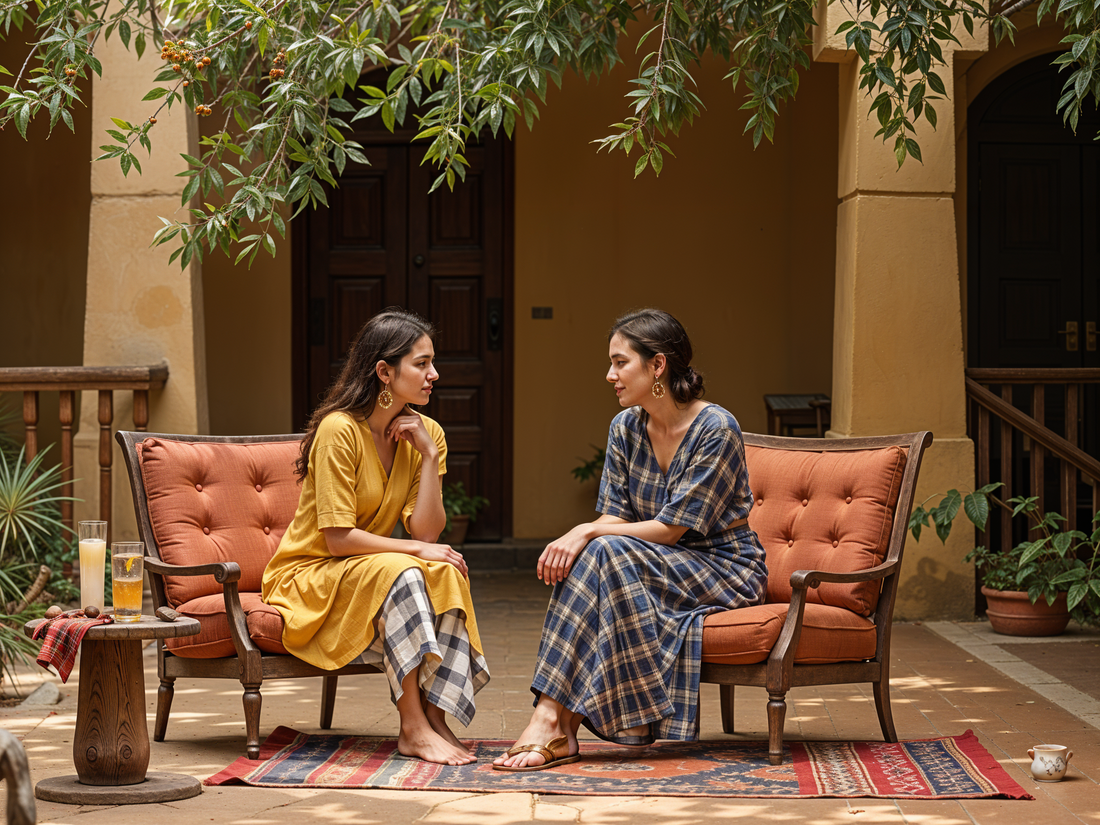Once upon a time, tartan belonged to the Scottish Highlands, carried proudly on kilts, symbolising clans, bloodlines, and loyalty. Then the punks hijacked it in the ‘70s, slashing it into skirts and safety-pinning it with fury. And now, in 2025, plaid tartan is once again reborn — not with the rage of rebellion, but with the quiet confidence of sustainability.
Plaid is no longer just a pattern. It’s a mindset.
Today, fashion is witnessing an unexpected but welcome return of tartan and plaid — not in their traditional avatar, but as reimagined canvases for slow fashion brands that care deeply about design, story, and impact.
The Global Revival of Checks
From the runways of New York to the indie boutiques of Bandra, there’s a renewed obsession with checks. And it’s not just nostalgia.
Plaid evokes structure, familiarity, even comfort. In a world that feels increasingly chaotic, there’s something grounding about intersecting lines. For brands like Harkoi Studio, tartan isn’t just visual texture; it’s emotional architecture.
Take the Mariko Dress in Multi Plaid. It doesn't shout. It understands restraint. The pattern is classic, but the silhouette? Utterly modern. The kind of dress that fits a picnic, a flight, a boardroom, or just a coffee on your balcony with Miles Davis playing in the background.
From Clan to Conscious
Historically, tartan was tribal. You wore your clan on your sleeve, quite literally. But in 2025, your tribe is ethical. Conscious. Curious. The fabric of identity has changed, and your wardrobe reflects it.
When you wear Harkoi’s Mini Gingham Men’s Shirt in Green Yellow or the Dual Stripes Akira Top in Pink Red, you’re not declaring allegiance to a family crest. You’re making a softer but more radical statement: that you care. About where it was made. About who made it. About the earth it came from.
The Cultural Shape-shifter
Tartan has had many lives. It was aristocratic. Then rebellious. Then preppy. Now, in its current chapter, it has found its way into ethical fashion closets in New Delhi and downtown Portland.
What makes this revival significant is the medium through which it flows. Brands like No Nasties and Osei-Duro are using natural fibres and plant-based dyes to reinvent the pattern without compromising the planet. Similarly, Harkoi is bringing a distinctly Indian design philosophy to plaid’s rigid geometry, making it softer, more fluid, more breathable.
Browse their Fuji Shirt in Windowpane Check and you’ll notice something intriguing: there’s depth in the restraint. The lines don’t just intersect; they converse.
The Psychology of the Pattern
Fashion psychologists have long agreed: patterns influence mood. Checks, with their rhythm and symmetry, lend a sense of order. But in plaid, that order is rarely rigid. It allows play. It's structured spontaneity.
This is particularly relevant in a post-pandemic world where hybrid wardrobes have become the norm. You want clothes that can adapt, like the Stripes Emi Pants in Blue — formal enough for Zoom calls, relaxed enough for a walk after.
Plaid as Protest
Let’s not forget: tartan has always had teeth. In the ‘70s, Vivienne Westwood turned it into punk iconography. And even today, there’s something quietly subversive about wearing it in ways it wasn’t intended for.
Pair a structured tartan shirt with organic cotton culottes, throw on a natural-dyed scarf, and you’ve essentially made a political statement without saying a word. Style isn’t just aesthetic anymore. It’s activism.
The Anti-Trend Trend
Plaid’s superpower? It never really goes out of style. It just goes quiet for a bit, then comes back with a whisper that turns into a roar. In 2025, that whisper is being carried on the shoulders of sustainable labels.
Collections like Old School tap into retro nostalgia while keeping the fabrics and process rooted in the future. Think: AZO-free dyes, no microplastics, and packaging that doesn’t make the planet weep.
The Abstract Shapes Camp Collar Top in Red and Mariko Dress Girard are perfect examples of this fusion. Shapes are relaxed but intentional. Patterns are familiar but not tired.
Keywords Meet Culture
For those of us thinking like SEO strategists (and we must), plaid and tartan hit the sweet spot between informational and transactional search intent. Users looking for "gingham dresses sustainable," "plaid tops eco-friendly," or "organic cotton tartan shirts" are not browsing. They’re buying.
Outbound platforms like Good On You and The Good Trade are seeing rising traffic to articles featuring plaid in their ethical wardrobe guides. Meanwhile, inbound links to product pages like Harkoi’s Mini Gingham Shorts in Pink Blue drive not just SEO juice but real emotional equity.
The Indian-American Bridge
Plaid doesn’t belong to any one culture now. It lives in many. It travels. A Bengali artisan can hand-dye a tartan pattern that ends up in a New Yorker’s wardrobe. A Bandra stylist can style a tartan crop top with jhumkas and jeans.
Fashion, after all, is the world’s most visible language.
And in this era of hyper-curated individuality, where algorithms guess what you want before you know it, there’s something oddly comforting about the symmetry of tartan. It allows expression within a grid. Chaos within reason.
A Pattern with a Pulse
So where does plaid go from here?
Into conscious closets. Onto university campuses. Across the backs of activists, artists, and even accountants who care about more than just trends. It enters boardrooms in the form of Check-on-Check Arka Shirts and weekend getaways through Stripes Emi Pants in Black.
It goes where the people are thinking. Feeling. Choosing.
The Final Thread
Plaid tartan is not just back. It’s been reborn. And this time, it’s carrying with it stories of handwoven heritage, design mindfulness, and ethical conviction.
In the hands of brands like Harkoi Studio, it’s not just a pattern. It’s a philosophy stitched into every seam.
Because in a world overwhelmed with noise, the neat lines of tartan are doing something radical: they’re helping us feel seen.
That, dear reader, is everyday elegance. That is plaid reimagined. That is sustainable style with a soul.

